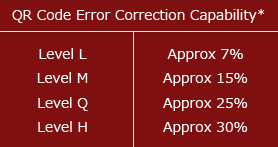QR Code Technology
High Capacity Encoding of Data
While conventional bar codes are capable of storing a maximum of approximately 20 digits, QR Code is capable of handling several dozen to several hundred times more information.
QR Code is capable of handling all types of data, such as numeric and alphabetic characters, Kanji, Kana, Hiragana, symbols, binary, and control codes. Up to 7,089 characters can be encoded in one symbol.

A QR Code symbol of this size can encode 300 alphanumeric characters.
Small Printout Size
Since QR Code carries information both horizontally and vertically, QR Code is capable of encoding the same amount of data in approximately one-tenth the space of a traditional barcode. (For a smaller printout size, Micro QR Code is available.)

Kanji and Kana Capability
As a symbology developed in Japan, QR Code is capable of encoding JIS Level 1 and Level 2 kanji character set. In case of Japanese, one full-width Kana or Kanji character is efficiently encoded in 13 bits, allowing QR Code to hold more than 20% data than other 2D symbologies.

Dirt and Damage Resistant
QR Code has error correction capability. Data can be restored even if the symbol is partially dirty or damaged. A maximum 30% of codewords*1 can be restored*2.

*1: A codeword is a unit that constructs the data area. In the case of QR Code, one codeword is equal to 8 bits. *2: Data restoration may not be fully performed depending on the amount of dirt or damage.
Readable from any direction in 360°
QR Code is capable of 360 degree (omni-directional), high speed reading. QR Code accomplishes this task through position detection patterns located at the three corners of the symbol. These position detection patterns guarantee stable high-speed reading, circumventing the negative effects of background interference.

Structured Appending Feature
QR Code can be divided into multiple data areas. Conversely, information stored in multiple QR Code symbols can be reconstructed as a single data symbol. One data symbol can be divided into up to 16 symbols, allowing printing in a narrow area.

Information capacity and versions of the QR Code
The symbol versions of QR Code range from Version 1 to Version 40. Each version has a different module configuration or number of modules. (The module refers to the black and white dots that make up QR Code.) "Module configuration" refers to the number of modules contained in a symbol, commencing with Version 1 (21 × 21 modules) up to Version 40 (177 × 177 modules). Each higher version number comprises 4 additional modules per side.

Each QR Code symbol version has the maximum data capacity according to the amount of data, character type and error correction level. In other words, as the amount of data increases, more modules are required to comprise QR Code, resulting in larger QR Code symbols.
Error Correction Feature
QR Code has error correction capability to restore data if the code is dirty or damaged. Four error correction levels are available for users to choose according to the operating environment. Raising this level improves error correction capability but also increases the amount of data QR Code size. To select error correction level, various factors such as the operating environment and QR Code size need to be considered. Level Q or H may be selected for factory environment where QR Code get dirty, whereas Level L may be selected for clean environment with the large amount of data. Typically, Level M (15%) is most frequently selected.

*Data restoration rate for total codewords (codeword is a unit that constructs the data area. One codeword of QR Code is equal to 8 bits.)
The QR Code error correction feature is implemented by adding a Reed-Solomon Code*to the original data. The error correction capability depends on the amount of data to be corrected. For example, if there are 100 codewords of QR Code to be encoded,50 of which need to be corrected, 100 codewords of Reed-Solomon Code are required, as Reed-Solomon Code requires twice the amount of codewords to be corrected. In this case, the total codewords are 200, 50 of which can be corrected. Thus, the error correction rate for the total codewords is 25%. This corresponds to QR Code error correction Level Q.
In the example above, the error correction rate for QR Code codewords can be considered as 50%. However, it is not always the case that codewords of not Reed-Solomon Code but only QR Code are susceptible to dirt and damage.QR Code therefore represents its error correction rate as a ratio of the total codewords.
*Reed-Solomon Code is a mathematical error correction method used for music CDs etc. The technology was originally developed as a measure against communication noise for artificial satellites and planetary probes. It is capable of making a correction at the byte level, and is suitable for concentrated burst errors.
Many ways of using QR Codes
QR Codes are contributing to making a variety of our activities both at home and at work convenient. It can be used in our daily life not only for printed matters such as fliers and name cards but also as a payment system. It can also be used for various business purposes at factories and in logistics operations. Since QR Codes are now used in such a wide variety of ways, they have now become an indispensable tool in our lives. This high functionality on a par with our way of living and its design quality are valued publicly, and in 2012 it was awarded a Good Design Award, an award from a design promotion initiative sponsored by the Japan Institute of Design Promotion, a public interest incorporated foundation.
History of QR Code Standardization
QR Code is standardized as shown in the table. It was approved as an international standard in June 2000. This shows that QR Code has been accepted internationally, ensuring its widespread acceptance not only in Japan, but also internationally.More information

 Sign in
Sign in